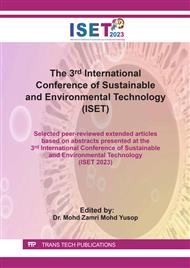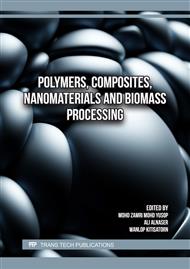[1]
Yang G, Li L, Lee WB, Ng MC. Structure of graphene and its disorders: a review. Science and technology of advanced materials. 2018; 19(1):613-48
DOI: 10.1080/14686996.2018.1494493
Google Scholar
[2]
Zahid MU, Pervaiz E, Hussain A, Shahzad MI, Niazi MB. Synthesis of carbon nanomaterials from different pyrolysis techniques: a review. Materials Research Express. 2018; 5(5):052002
DOI: 10.1088/2053-1591/aac05b
Google Scholar
[3]
Shams SS, Zhang LS, Hu R, Zhang R, Zhu J. Synthesis of graphene from biomass: a green chemistry approach. Materials Letters. 2015; 161:476-9
DOI: 10.1016/j.matlet.2015.09.022
Google Scholar
[4]
Zhou Q, Lin L. Synthesis of graphene using micro chemical vapor deposition. In 2010 IEEE 23rd International Conference on Micro Electro Mechanical Systems (MEMS) 2010; (pp.43-46). IEEE
DOI: 10.1109/MEMSYS.2010.5442571
Google Scholar
[5]
Siddique R, Cachim P. Waste and supplementary cementitious materials in concrete: characterisation, properties and applications. Woodhead Publishing; 2018 (p.417–460). Elsevier
DOI: 10.1016/B978-0-08-102156-9.00013-4
Google Scholar
[6]
Huang H, Chen S, Wee AT, Chen W. Epitaxial growth of graphene on silicon carbide (SiC). In Graphene: Properties, Preparation, Characterisation and Devices. 2014;3–26
DOI: 10.1533/9780857099334.1.3
Google Scholar
[7]
Wang YF, Zou SJ, Hu WP, Wu FF, Yang JX, Cen YY, Yang DX, Hou ZQ, Huang KJ. Biomass-derived graphene-like carbon nanoflakes for advanced supercapacitor and hydrogen evolution reaction. Journal of Alloys and Compounds. 2022;928:167176.
DOI: 10.1016/j.jallcom.2022.167176
Google Scholar
[8]
Urade AR, Lahiri I, Suresh KS. Graphene properties, synthesis and applications: a review. JOM. 2023;75(3):614-30.
DOI: 10.1007/s11837-022-05505-8
Google Scholar
[9]
Aboul-Enein AA, Awadallah AE, Abdel-Rahman AAH, Haggar AM. Synthesis of multi-walled carbon nanotubes via pyrolysis of plastic waste using a two-stage process. Fullerenes, Nanotubes and Carbon Nanostructures. 2018; 26(7):443-450
DOI: 10.1080/1536383X.2018.1447929
Google Scholar
[10]
Thangaraj B, Mumtaz F, Abbas Y, Anjum DH, Solomon PR, Hassan J. Synthesis of Graphene Oxide from Sugarcane Dry Leaves by Two-Stage Pyrolysis. Molecules. 2023;28(8):3329
DOI: 10.3390/molecules28083329
Google Scholar
[11]
Widiatmoko P, Sukmana IF, Nurdin I, Prakoso T, Devianto H. Increasing yield of graphene synthesis from oil palm empty fruit bunch via two-stages pyrolysis. In IOP Conference Series: Materials Science and Engineering. 2019; 543(1):012032
DOI: 10.1088/1757-899X/543/1/012032
Google Scholar
[12]
Ukanwa KS, Patchigolla K, Sakrabani R, Anthony E, Mandavgane S. A review of chemicals to produce activated carbon from agricultural waste biomass. Sustainability. 2019; 11(22):6204
DOI: 10.3390/su11226204
Google Scholar
[13]
Balasubramanian R, Chowdhury S. Recent advances and progress in the development of graphene-based adsorbents for CO 2 capture. Journal of Materials Chemistry A. 2015;3(44):21968-89
DOI: 10.1039/c5ta04822b
Google Scholar
[14]
S Maulina and M Iriansyah. Characteristics of activated carbon resulted from pyrolysis of the oil palm fronds powder. IOP Conference Series: Materials Science and Engineering. 2018; 309:012072
DOI: 10.1088/1757-899X/309/1/012072
Google Scholar
[15]
Tazibet S, Velasco LF, Lodewyckx P, Abou M'Hamed D, Boucheffa Y. Systematic study of the role played by ZnCl2 during the carbonization of a chemically activated carbon by TG–MS and DSC. Journal of Thermal Analysis and Calorimetry. 2018; 134(3): 1395-1404
DOI: 10.1007/s10973-018-7246-3
Google Scholar
[16]
Alwaan IM, Jaleel MA. Preparation and Characterization of Activated Carbon with (ZnCl2 - Activated) from (PET) Bottle Waste for Removal of Metal ions (Cu+2) in Aqueous Solution. In IOP Conference Series: Materials Science and Engineering. 2021; 1094(1): 012131. https://doi.org/
DOI: 10.1088/1757-899X/1094/1/012131
Google Scholar
[17]
Luo Y, Zeng L, Zhao Y, Zhao Z, Wei M, Jiang B, Fan J, Li D. Roles of ZnCl2 and FeCl3 in preparing high performance corn stover-based carbon materials for efficient removal of Cr (VI) from wastewater. Journal of Water Process Engineering. 2022. 47:102743
DOI: 10.1016/j.jwpe.2022.102743
Google Scholar
[18]
Liu W, Dang T, Xiao Z, Li X, Zhu C, Wang X. Carbon nanosheets with catalyst-induced wrinkles formed by plasma-enhanced chemical-vapor deposition. Carbon. 2011;49(3):884-9
DOI: 10.1016/j.carbon.2010.10.049
Google Scholar
[19]
Kong X, Zhu Y, Lei H, Wang C, Zhao Y, Huo E, Lin X, Zhang Q, Qian M, Mateo W, Zou R. Synthesis of graphene-like carbon from biomass pyrolysis and its applications. Chemical Engineering Journal. 2020;1(399):125808
DOI: 10.1016/j.cej.2020.125808
Google Scholar
[20]
Moutinho MV, Venezuela P, Pimenta MA. Raman Spectroscopy of Twisted Bilayer Graphene. C. 2021; 7(1):10. https:// doi.org/
DOI: 10.3390/C7010010
Google Scholar
[21]
Rabelo C, Vasconcelos TL, Publio BC, Miranda H, Cançado LG, Jorio A. Linkage between micro-and nano-Raman spectroscopy of defects in graphene. Physical Review Applied. 2020;14(2):024056
DOI: 10.1103/PhysRevApplied.14.024056
Google Scholar
[22]
Robert Bigras G, Vinchon P, Allard C, Glad X, Martel R, Stafford L. Probing plasma-treated graphene using hyperspectral Raman. Review of Scientific Instruments. 2020;91(6)
DOI: 10.1063/5.0006556
Google Scholar
[23]
Johra FT, Lee JW, Jung WG. Facile and safe graphene preparation on solution based platform. Journal of Industrial and Engineering Chemistry. 2014; 20(5):2883-2887
DOI: 10.1016/j.jiec.2013.11.022
Google Scholar
[24]
Kroening M, Martens B, Schaefer J. Method for determining material defects in a sample. 1985.
Google Scholar
[25]
Lee H, Lee SW, Lee K. High-Quality Electrochemically Exfoliated Graphene Protective Layer for Metal Batteries. Electrochemical Society Meeting Abstracts 242. 2022;8:663-663
DOI: 10.1149/MA2022-028663mtgabs
Google Scholar
[26]
Suhdi, Wang S-C. Fine Activated Carbon from Rubber Fruit Shell Prepared by Using ZnCl2 and KOH Activation. Appl. Sci. 2021; 11:3994
DOI: 10.3390/app11093994
Google Scholar
[27]
Zhang S, Zhu J, Qing Y, Wang L, Zhao J, Li J, Tian W, Jia D, Fan Z. Ultramicroporous Carbons Puzzled by Graphene Quantum Dots: Integrated High Gravimetric, Volumetric, and Areal Capacitances for Supercapacitors. Advanced Functional Materials. 2018;1805898:1-10. https://
DOI: 10.1002/adfm.201805898
Google Scholar
[28]
Liu Y, Wang S, Meng X, Ye Y, Song X, Liang Z. Increasing the surface area and CO 2 uptake of conjugated microporous polymers via a post-knitting method. Materials Chemistry Frontiers. 2021;5(14):5319-27.
DOI: 10.1039/d1qm00371b
Google Scholar
[29]
Kole K, Das S, Samanta A, Jana S. Parametric study and detailed kinetic understanding of CO2 adsorption over high-surface-area flowery silica nanomaterials. Industrial & Engineering Chemistry Research. 2020;59(49):21393-402
DOI: 10.1021/acs.iecr.0c04531
Google Scholar
[30]
Garba A, Basri H, Nasri NS. Preparation and characterization of green porous palm shell based activated carbon by two step chemical activation using KOH. Applied Mechanics and Materials. 2015;773:1127-32.
DOI: 10.4028/www.scientific.net/amm
Google Scholar



